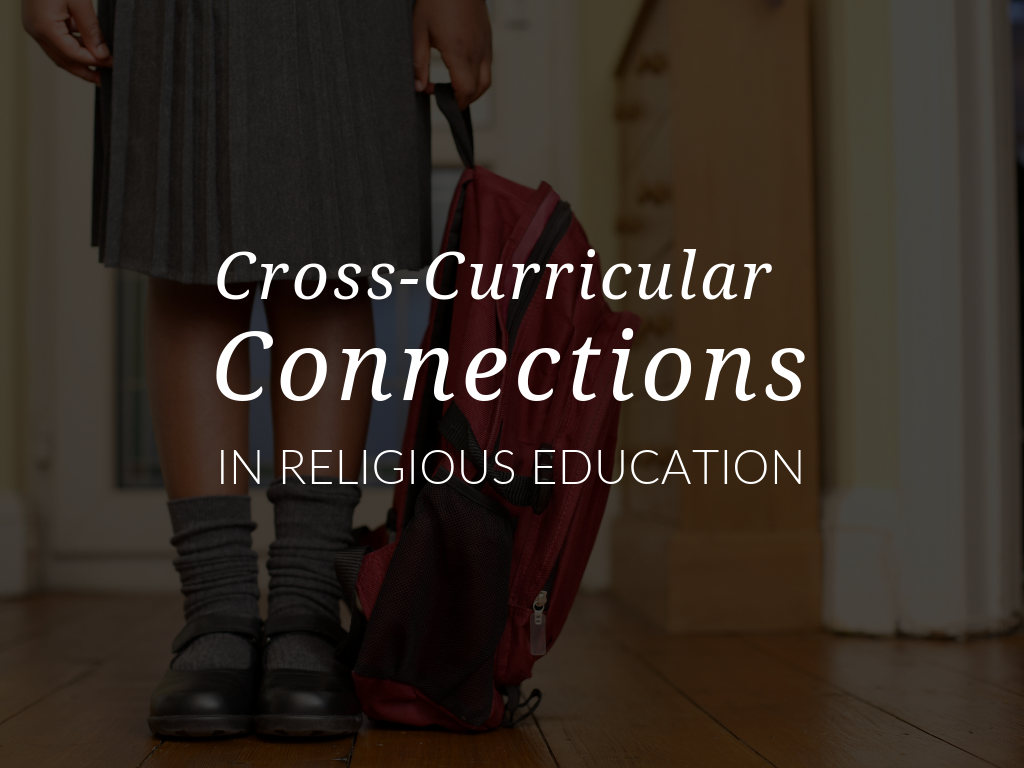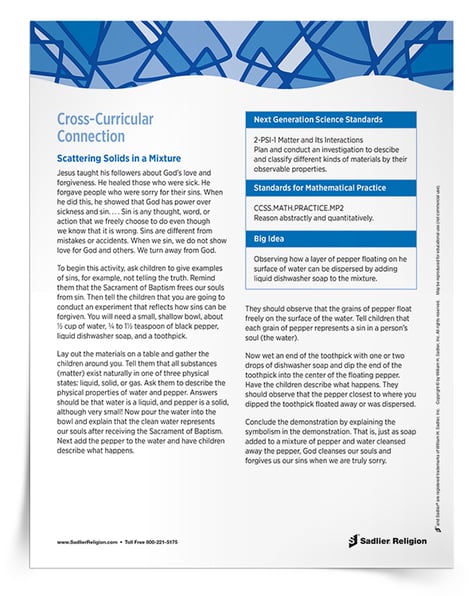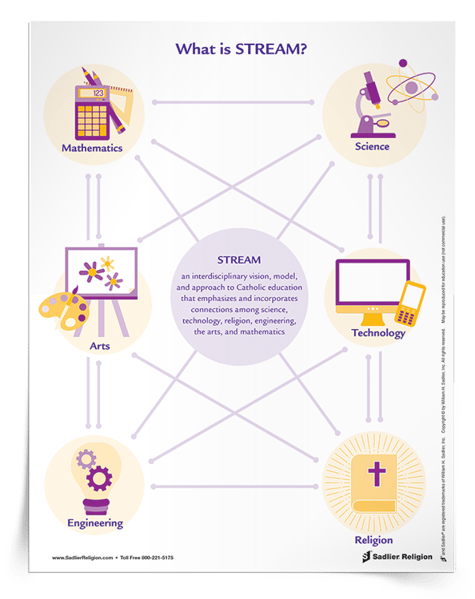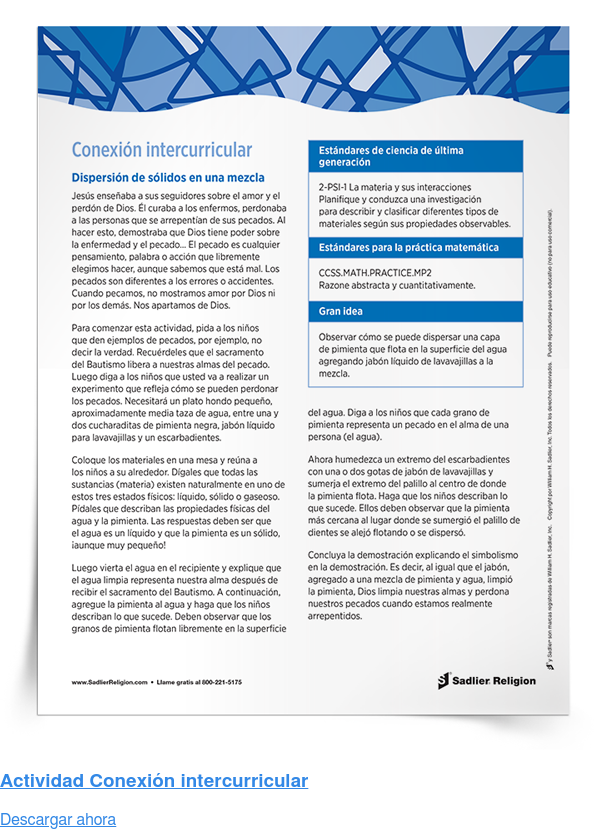March 26, 2019 WBB Primary, WBB Intermediate, WBB Scripture, REL Asset - Activity, REL Catechetical - K–6, REL Topic - Catechesis, REL PD - Catechist, REL Topic - Methodology
In this article, you'll discover how STREAM curriculum and using cross-curricular connections can help students and children in your religious education program see the interconnectedness of Religion and academic subjects. Plus, download a Cross-Curricular Connection Activity that primary grade teachers and catechists can use to connect forgiveness with science and mathematics.

From STEM to STEAM to STREAM
STEM, an acronym for the subjects Science, Technology, Engineering and Mathematics, was coined around 2001 as educators sought to integrate these core subjects in a meaningful way and to advance 21st century learning. Critical thinking, collaboration and innovation are all key traits that teachers and catechists model as they move away from more traditional, segmented ways of learning to a more modern and integrated approach. It wasn’t long before the STEM movement expanded and included an “A” as a representation for the Arts, becoming STEAM. Between the analytical reasoning of mathematical and science concepts and the creative design processes of the arts, the transition from STEM to STEAM was largely supported. In 2014 the acronym went from STEAM to STREAM. In some settings, the “R” represents Robotics. But in Catholic Education, it has been used to incorporate Religion into the mix.
STREAM-lined Learning
During a speech he gave in Cairo as part of journey of unity and fraternity, Pope Francis spoke about education. He said, “it is through education that man can transcend himself.” For Catholic students, catechesis and faith formation are an integral part of this education. STREAM oriented curriculum allows teachers, catechists, and parents the opportunity to, quite literally, stream-line learning in a broad, cross-curricular manner, linking Religion with these core academic subjects.
To support a STREAM-lined approach in your Catholic school, you might begin by bringing together a team of subject area experts. Include those who specialize in Science, Technology, Engineering, the Arts, and Religious Education. Map out core units of study for each subject and choose one or two to focus on. See how many connections you can make among the STREAM subjects. Does an environmental science unit have ramifications for discussions in Religious Education? Does a math lesson connect to patterns in nature, an art application, and a discussion of the wonder of God’s creation? Challenge the teachers to adapt unit plans to incorporate these connections and help students see and discuss them.
STREAM is not just for Catholic Schools. To support a STREAM-lined approach in your parish religious education program, encourage catechists to help students make natural connections across disciplines that relate to what they are learning about their Catholic faith. Current news, both local and global, might inspire conversations about the ways that Religion naturally intersects with Science, Technology, Engineering, the Arts, and Mathematics. These connections will be especially powerful when sparked by children’s understanding of where these subjects and their Catholic faith meet in powerful and meaningful ways. Making connections may be as simple as asking the children in your program if anything that they are learning at school connects to the topics you are exploring in religious education!
Making Cross-Curricular Connections with Religion
When you cannot STREAM-line an entire unit of study within your curriculum that includes all of the STREAM subjects, you can forge cross-curricular connections among Religion and these subjects. Here are a few simple suggestions to effortlessly connect Religion with the STEAM subjects, whether you are in a Catholic school or a parish setting.
Religion and Science
Many saints had occupations or interests in the STEAM subjects. As you teach students about the lives of the saints, point out any connections to concepts or topics your students may be exploring in science or that are particularly relevant in the news. Students will enjoy discovering a saint who dedicated time to a scientific field! For example:
- Saint Anatolius of Laodicea explored the natural sciences.
- Saint Richard Pampuri and Saint Gianna Beretta Molla were doctors.
- Saint Abbo of Fleury was an astronomer.
For another cross-curricular connection to Science for a religious education lesson about forgiveness, download a Cross-Curricular Connection Activity to share with primary grade teachers and catechists. This download is ideal for Catholic school teachers, but also a fun hands-on activity that catechists could do in a parish with just a few easily obtainable materials that would engage the children.

Religion and Technology
Make use of appropriate digital technology and applications to help engage students and to support them in being missionary disciples in a modern world. Older students may enjoy using digital programs to create projects in Religious Education or explore applications that help them to discover more about their faith, like a digital tour of the Vatican museum, a live stream of the pope’s activities or an event such as World Youth Day, or digital editions of the Bible.
Today’s students live as digital natives in a fast-paced world. On a daily basis, students interact with technology as an educational, recreational and communication tool. Spark a conversation with students about what it means to be a digital citizen, and ways that being Catholic impacts the way that we “act” and “speak” in both the real world and in the virtual world.
For an interesting and in-depth look at this the topic of missionary discipleship for digital natives, check out the Heart and Soul: Missionary Discipleship in a Digital World Webinar, presented by Andrea Chavez-Kopp, MEd.
Religion and Engineering
Engineers play a vital role in the world in the development of infrastructure, communities, and even the machines that we rely on in our personal and business lives. Engineers can respond to global challenges with good design and solutions for problems. Invite conversation with students about ways that today’s engineers and tomorrow’s engineers can and should consider the rights and responsibilities of all people in their work. How are new innovations supporting or not supporting efforts in Catholic social teaching today?
Religion and Art
The arts are a vast field, and connections between Religion and the Arts abound. Prayer is a wonderful opportunity to incorporate music and movement or dance. Lectio and visio divina provide opportunities to develop students spiritually and make connections between Scripture and art.
Fine art is another area of study rich with connections. Throughout the ages, artists have used art to depict scenes from Scripture or events in the lives of Jesus, Mary, and the saints. Invite older students to explore well known religious art, such as Leonardo da Vinci’s The Last Supper or even modern religious art. They may be inspired to use an artistic medium to create their own religious expression as well!
Religion and Mathematics
Mathematics offers many possibilities to integrate religion into the lesson. Share Noah’s Ark with younger learners and focus on counting two by two or explore things that come in pairs. Praying a decade of the rosary would be a great way to showcase sets of 10. Look to the Bible for stories where counting, patterning, and other mathematical concepts can be explored and supported.
Invite Students to Discover Connections
A STREAM curriculum provides learners the opportunity to think critically and collaborate with their peers on a whole new level. Invite students to discover cross-curricular connections on their own! As a discovery exercise, divide students into groups. Assign each group a complimentary topic: Science and Religion, Technology and Religion, Engineering and Religion, Art and Religion, or Mathematics and Religion. Invite each group to work together to create a poster or a digital presentation representing their team’s topic. Provide supplies for students. Then, invite the entire class to collaborate as a whole to position each poster together to create an infographic. Display in an area where its contents and message can be shared with others.
More Support for the STREAM-minded
A STREAM curriculum and using cross-curricular connections are great ways to help students and children in your religious education program see the interconnectedness of these important areas of study and their application in real life. While it can feel overwhelming at the start of implementation for educators and catechists alike, there are ways to seek out guidance and resources if you are looking to make more STREAM connections. The National Catholic Education Association shares countless tips and lesson suggestions and offers professional development.
Remember to start small and to make cross-curricular connections whenever you can in your school and parish!
To garner support for beginning STREAM initiatives and supporting an interdisciplinary approach to Science, Technology, Religion, Engineering, Art, and Mathematics, download the What is STREAM? Faith Fact. A simple infographic explains and promotes STREAM for display or distribution, and is available in English and Spanish.







